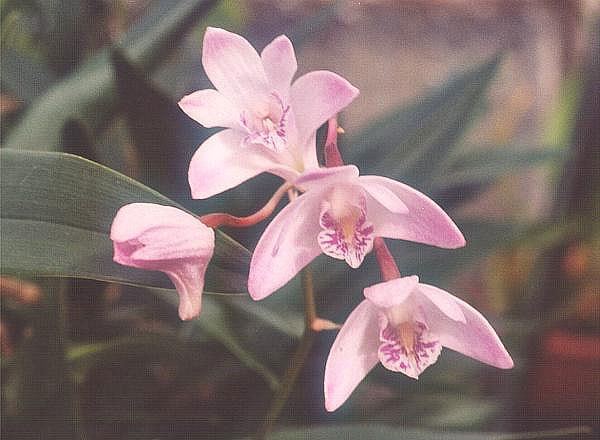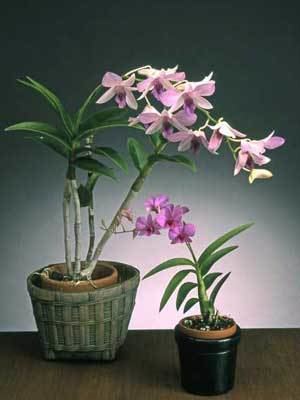Subtribe Dendrobiinae Higher classification Dendrobiinae | Scientific name Dendrobium | |
 | ||
Lower classifications Dendrobium nobile, Vappodes phalaenopsis, Dendrobium moniliforme, Dendrobium anosmum, Dendrobium kingianum | ||
How to propagate dendrobium nobiles
Dendrobium is a huge genus of orchids. It was established by Olof Swartz in 1799 and today contains about 1,200 Species. The genus occurs in diverse habitats throughout much of south, east and southeast Asia, including China, Japan, India, the Philippines, Indonesia, Australia, New Guinea, Vietnam, and many of the islands of the Pacific. The name is from the Greek dendron ("tree") and bios ("life"); it means "one who lives on trees", or, essentially, "epiphyte".
Contents
- How to propagate dendrobium nobiles
- Japanese orchid plant show dendrobium calanthe and assorted species
- Description
- In horticulture
- Other uses by humans
- References

In 1981, Briegar reclassified all terete-leaved Dendrobiums from Australia and New Guinea into a new genus, Dockrillia. The Winika orchid from New Zealand was formerly D. cunninghamii, but has now been moved into a monotypic genus Winika. In 1989, Clements upgraded the D. speciosum complex into individual species; similarly, the D. bigibbum complex (which contains the well-known Cooktown Orchid of Australia, D. phalaenopsis) has recently been split up. However, as an illustration of the current revisions in the taxonomy of Orchidaceae these 'splits' have now been reversed and the currently accepted species, natural nothospecies are presented on Wikispecies Dendrobium. The site includes a list of references that help explain the contemporary taxonomy of Dendrobium Sw., Nova Acta Regiae Soc. Sci. Upsal. 6: 82 (1799), nom. cons.

Japanese orchid plant show dendrobium calanthe and assorted species
Description

Dendrobium species are either epiphytic, or occasionally lithophytic. They have adapted to a wide variety of habitats, from the high altitudes in the Himalayan mountains to lowland tropical forests and even to the dry climate of the Australian desert.

This genus of sympodial orchids develop pseudobulbs, which vary in length from under a centimetre (e.g. Dendrobium leucocyanum) to several metres long (e.g. Dendrobium discolor), resembling canes. A few grow into long reedlike stems. Leaf bases form sheaths that completely envelope the stem. In the section Formosae (e.g. Dendrobium infundibulum), the sheaths and undersides of leaves are covered with fine short black hairs. Other species (e.g. Dendrobium senile), are covered with fine white hairs.

In selected species, the short, ovate leaves grow alternately over the whole length of the stems, in others, the leaves are bunched towards the apex of the stem (e.g. Dendrobium tetragonum). The axillary inflorescence vary in length from insignificant to 1 metre long, and can carry from a few (1-4) (e.g. Dendrobium nobile) to as many as 100 (e.g. Dendrobium speciosum) flowers. Deciduous species carry their leaves for one to two years then typically flower on leafless canes, while canes of evergreen species usually flower in the second year and can continue to flower for a number of years (e.g. Dendrobium densiflorum).

These orchids grow quickly throughout summer, but take a rest during winter. Dormant buds erupt into shoots from the base of the pseudobulb mainly in spring, and a few species in autumn. This is then followed by rapid growth of new roots. Reproduction is usually through seed, but a few species reproduce asexually through keikis produced along the stem, usually after flowering and sometimes as a result of injury to the growing tip.
In horticulture
Dendrobium is commonly abbreviated as Den in horticulture. Some species are in great demand by orchid lovers. This has resulted in numerous varieties and hybrids, such as the Noble Dendrobium (D. nobile) breeds, which have greatly extended the range of colors of the original plant from the Himalayas. The flowers of Cuthbertson's Dendrobium (D. cuthbertsonii) have been reported to last up to ten months each.
Many Dendrobium species are known to vigorously remove toluene and xylene from the air.
Several hybrids in this genus have been registered and named after notable persons and institutions:
Other uses by humans
Some Dendrobium species are cultivated as medicinal plants. The Noble Dendrobium (D. nobile) for example is one of the 50 fundamental herbs used in traditional Chinese medicine, where it is known as shí hú (石斛) or shí hú L.n (石斛兰).
Many species and cultivars of this genus are well-known floral emblems and have been figured in artwork. Among the former are:
The Cooktown Orchid was figured on Australian stamps in 1968 and 1998, and several Dendrobium cultivars are depicted on the obverse side of the Singapore Orchid Series currency notes issued between 1967 and 1976:
The Golden-bow Dendrobium (D. chrysotoxum), colloquially called "Fried-egg Orchid" was one of the species grown by the fictional private detective and orchid fancier Nero Wolfe, and plays a role in The Final Deduction.
